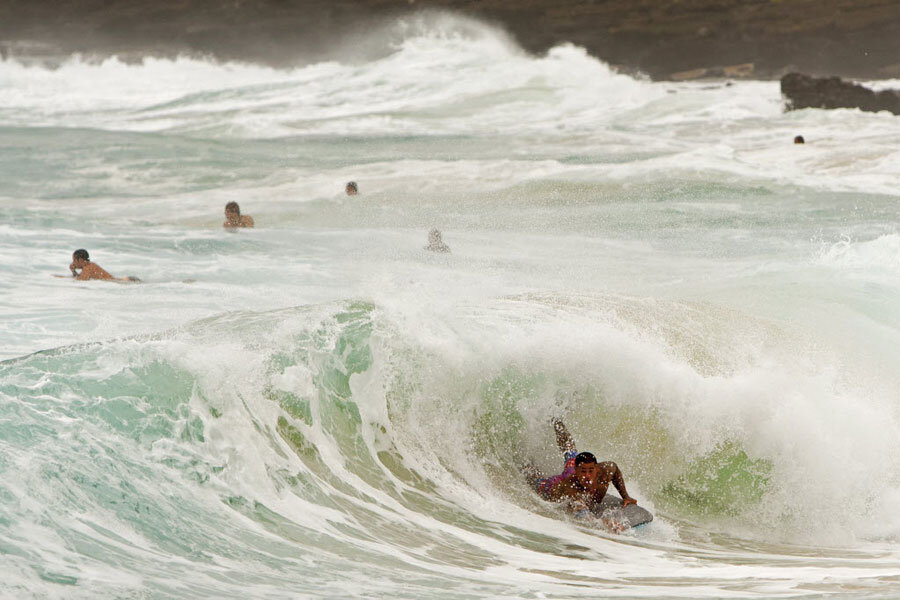As storm passes over Hawaii, surfers play
Loading...
As the first tropical storm to hit Hawaii in 22 years passed by the islands, some coffee farmers on the Big Island navigated flooded roads to assess damage to their crops Friday while residents and tourists wandered the beaches of Oahu and surfers took to the waves as wind and rain let up.
The first storm in a one-two punch bound for Hawaii clamored ashore overnight Friday as a weakened tropical storm. A second system behind it also weakened and was on track to pass well north of the islands early Sunday.
Tropical Storm Iselle knocked out power, caused flooding and downed trees when it crossed onto the Big Island in a rural and sparsely populated region. There have been no reports of major injuries, Gov. Neil Abercrombie said Friday.
Heavy rains and wind from the storm's outer bands hit Maui and Oahu on Friday morning but eased later in the day as Iselle swirled farther out to sea.
Those staying in shelters were told to return home, while crews and some residents used chain saws to clear trees from roads.
On Oahu's south shore, near Honolulu, the cloudy skies started to give way to patches of blue as tourists and residents ventured out to see the surf.
"We've never seen the water crash into the rocks the way they are. It's just beautiful," said Army Sgt. Steven Reyes, who drove to the coast with his mother after his home on a central Oahu Army base lost power.
Honolulu's lifeguard division said about a dozen surfers were riding waves Friday at a spot nicknamed "Suicides," near the popular Diamond Head crater. Lifeguards on Oahu planned only to respond to emergency calls, avoiding regular patrols.
At 8 p.m. Friday Hawaii Standard Time, the National Weather Service canceled the tropical storm warning for all of the Hawaiian islands.
Even then, the National Park Service said it would keep its popular memorial sites at Pearl Harbor in Oahu closed through Saturday as staff keeps an eye on Hurricane Julio.
The state Department of Health warned the public to stay out of floodwaters and storm water runoff across Hawaii because they are known to attract sharks as they wash possible dead animals into the ocean.
The storm affected some Big Island residents who planned to vote in Saturday's primary election: State elections officials say they will postpone the primary election for about 8,000 voters in two precincts on the island because of nearby road damage caused by the storm. The roads left communities in Puna isolated, Chief Election Officer Scott Nago said in a statement Friday.
The rest of the primary will move forward as planned, and the two precincts will vote absentee later, Nago said.
Back on the Big Island, coffee farmers on the southeastern side tried to get around fallen trees on flooded roads to determine any crop damage, said Randy Stevens, general manager of Kau Coffee Mill.
The heavy rain and flooding seen in the southeastern Kau district was vastly different from the relatively drier Kona region on the Big Island's western side, where much more coffee is grown, and the storm had little impact.
"We're all buttoned up, but nothing happened," said Bruce Corker, a Kona coffee farmer.
Meanwhile, Hurricane Julio, about 750 miles east of the Big Island, was a Category 2 storm and packed maximum sustained winds of about 105 mph. National Weather Service officials predict it will continue to weaken on a path that should take it about 200 miles north of the island chain starting sometime Sunday morning.
If Julio stays on track, "the impacts to the islands would be minimal," Weather Service meteorologist Derek Wroe said. "We would see some large surf. ... We could see some heavy showers. That's all assuming this track holds. Otherwise, we could still see some tropical storm conditions."
Iselle also weakened Friday after being downgraded from a hurricane to a tropical storm about 50 miles from shore late Thursday as wind shear and the Big Island's mountainous terrain chipped away at its strength, experts said.
Hurricanes or tropical storms had directly hit Hawaii only three times since 1950. The last time was in 1992, when Hurricane Iniki killed six people and destroyed more than 1,400 homes in Kauai.
The state prepared for the back-to-back storms by closing government offices, schools and transit services across Hawaii. But Saturday's primary elections, including congressional and gubernatorial races, will go forward.
Travelers faced disrupted plans as several airlines canceled dozens of flights Thursday, but most flights weren't interrupted Friday. Some airlines waived reservation change fees and fare differences for passengers who needed to alter their plans.
The storms are rare in Hawaii but not unexpected in El Nino years, a change in ocean temperature that affects weather around the world.
Ahead of this year's hurricane season, weather officials warned the wide swath of the Pacific Ocean that includes Hawaii could see four to seven tropical storms this year.







